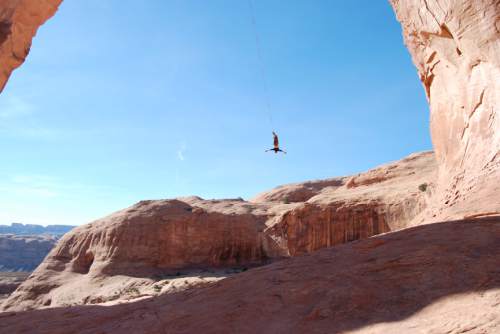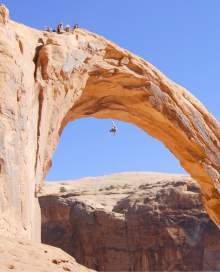This is an archived article that was published on sltrib.com in 2015, and information in the article may be outdated. It is provided only for personal research purposes and may not be reprinted.
The rope-swinging party is over at Corona Arch.
Bureau of Land Management leaders on Tuesday announced a two-year ban on roped activities at the iconic Utah sandstone formation near Moab that became a thrill-seeking hotspot after YouTube videos were posted in 2012 showing people using it as a 100-foot pendulum ride.
Federal land managers also banned such extreme sports at Gemini Bridges.
"This temporary restriction provides the BLM with time to continue working with the public to develop appropriate recreation management strategies for these two popular recreation destinations," said Beth Ransel, BLM's Moab field office manager.
The banned activities include ziplining, highlining, slacklining, climbing and rappelling.
Corona sits in a sandstone bowl at the end of a 1.5-mile hike from a BLM trailhead on the Colorado River. About 40,000 people a year hike to the feature, which includes Bowtie Arch. The federal agency acquired Corona in a massive land exchange with the state less than a year ago.
Visitors had frequently complained to the agency that rope swinging detracted from what should be a quiet and peaceful experience of nature. Swinging creates a circus atmosphere with much yelling and whooping as riders sail back and forth through the arch.
"The rope swingers are a new breed," said Grand County Council member Chris Baird, a climber on the board of Friends of Indian Creek. "If one person is ruining the experience of thousands of people, you have to say there are other places in the desert to go swinging around."
Until last May, Corona sat on a one-square-mile section of state land and the BLM was powerless to regulate activity there. The Utah School and Institutional Trust Administration, or SITLA, put an end to commercial guiding there out of liability concerns in early 2013.
At the time, one guide warned that do-it-yourselfers would get hurt because rigging the rope for safe swinging requires knowledge and experience that few would-be swingers possess.
The prediction proved accurate. A young man from West Jordan plunged to his death on the end of a rope that was too long in front 70 people in March 2013.
Just days before the land transfer took effect last May, another man was critically injured after attaching his swing rope to the wrong anchor.
Within days, the BLM proposed eliminating swinging at Corona and initiated an Environmental Assessment, which culminated in a decision signed Tuesday by Ransel.
"Restricting roped activities at the two locations would allow the majority of users (hikers) to enjoy the experience of viewing the arches unfettered by dangling apparatus and people," she wrote, and would "prevent further scarring and bolting on the natural features, which are the most-visited arches on BLM public [lands] in the Moab area."
The bans apply to 31 acres around Corona Arch and 6.3 acres around Gemini Bridges, twin 80-foot spans a few feet apart that people used to drive across. The area around Gemini Bridges now is a popular hiking and biking spot located between State Route 313 and the Potash Road, visited by about 50,000 people a year.
Gemini is no stranger to tragedy. In 1999, a motorist plunged off one of the bridges. A decade later, a Boy Scout's jump between spans came up fatally short. And a rappelling mishap claimed the life of a Salt Lake City man in 2013 after he swung on a rope from a cable strung across nearby Day Canyon.
Gemini Bridges also has been used for slacklining, where people walk on a rope stretched between the twin spans. And people have rigged ziplines between the canyon wall and the bridges and rappel lines between the bridges into the 150-foot chasm below. While those activities are no longer allowed, visitors may continue rappelling on the east wall of the bowl supporting the bridges.
BLM considered alternatives that would have allowed roped sports at certain times, under a permit system and as a commercially guided activity. But those variations would not have accomplished the agency's goal, the environmental assessment concluded.
"While requiring a permit could lessen the number of people engaged in roped activities, the user conflict would still persist," the analysis said. "Visitors to Corona Arch and Gemini Bridges come from all over the United States and the world. These visitors might be able to visit Corona Arch on only one day in their entire lives."





